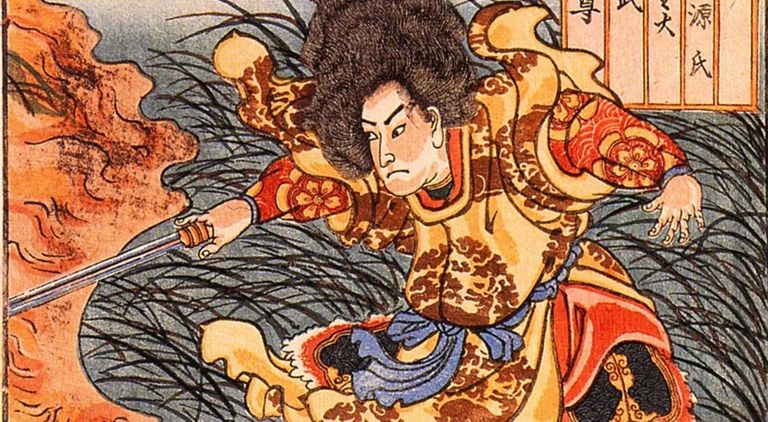Japanese mythology features a vast pantheon of deities—from the primordial creator gods to legendary heroes like Emperor Jinmu. Drawing from various ancient texts and legends, this article presents a ranking of the most powerful and fearsome gods, as originally compiled on a Japanese forum. Each figure’s myth and unique characteristics are explored in detail, with both Japanese and English names provided to guide readers through the rich depth and allure of Japan’s ancient legends.
EX Class – Betsatenjin (別天津神)
天之御中主神 (Ame-no-Minakanushi-no-Kami)
In the very moment of the creation of heaven and earth, this god appears as the first deity. He is one of the betsatenjin (separate heavenly gods) and a member of the three creative deities (造化三神), symbolizing the primordial force of creation.
高皇産霊神 (Takamimusubi-no-Kami)
Also known as Takamimusubi-no-Kami in the Kojiki, this deity emerges right after Ame-no-Minakanushi during the creation process in Takamagahara (the High Celestial Plain). His name, meaning “the divine producer of life,” emphasizes the power of generation and creation.
神産巣日神 (Kamimusubi-no-Kami)
Appearing shortly after Ame-no-Minakanushi and Takamimusubi, Kamimusubi-no-Kami is another of the three creative deities. As his name implies, he is the personification of the creative force that brings life into being.
宇摩志阿斯訶備比古遅神 (Umashiashikabihikoji-no-Kami)
One of the separate heavenly gods present during the formation of the world, this deity’s story varies slightly between texts. In the Kojiki he is known by this name, while the Nihon Shoki refers to him as Kamishikabihikoji. He is said to have emerged when the primordial world, still resembling a floating, jelly-like substance, was given form by an extending reed. He represents vitality, energy, and life force.
天之常立神 (Ame-no-Tokotachi-no-Kami)
The last of the five betsatenjin to appear during the creation, Ame-no-Tokotachi-no-Kami is unique for his solitary nature and his swift retreat into hiding. He symbolizes the eternal constancy of the heavens, having emerged even before some other deities like Kamishikabihikoji and Kuninotokotachi-no-Kami.
S Class
建葉槌命 (Takehazuchi-no-Mikoto)
Known in the Nihon Shoki as Takehazuchi-no-Mikoto (and as Ame-no-Hazuchi-onokami in the Kogo Shūi), this deity is revered as the progenitor of weaving—and an unexpectedly formidable warrior. He is famed for subduing the star deity known as Amatsumikaboshi (also known as Hoshi-no-Kagaseo or Amakagaseo), proving his might in celestial battles.
A Class
天津甕星 (Amatsumikaboshi)
Also called Ama-no-Kagaseo, this star deity is so powerful that even the likes of the gods of swords—such as Futsunushi-no-Kami and Takekunagatsuchi-no-Kami—could not defeat him. Often depicted as malevolent, Amatsumikaboshi stands as one of the most daunting figures in the celestial pantheon.
B Class
天之尾羽張神 (Ame-no-Ohabari-no-Kami)
This deity is closely linked to the divine sword and represents both creation and destruction. The legendary sword he embodies was used by Izanagi to slay Kagutsuchi (the fire deity), marking both the beginning of creation and the onset of death.
経津主神 (Futsunushi-no-Kami)
The personification of the sword, Futsunushi-no-Kami is the divine embodiment of the blade that cuts through chaos. Sent from Takamagahara as the final envoy, he played a crucial role in persuading Ōkuninushi (Great Land Master) to yield the land.
建御雷神 (Takeminakata-no-Kami)
A formidable god of thunder and sword, Takeminakata-no-Kami descended to Izumo on orders from Amaterasu, subduing the god of terrestrial affairs, Takeminakata-no-Kami’s counterpart, and compelling Ōkuninushi to surrender his kingdom. Worshipped at Kashima Shrine in Ibaraki Prefecture, he is also known as Kashima-no-Kami and is linked with both lightning and the mythic giant catfish believed to cause earthquakes.
C Class
素戔嗚尊 (Susanoo-no-Mikoto)
The brother of Amaterasu, Susanoo is known for his wild temperament and martial prowess. Famed for slaying the eight-headed serpent Yamata-no-Orochi and marrying Kushinada-hime, he also fathered Ōkuninushi. His many names across texts (such as Takehayasu Susanoo and Susa-no-O) reflect his multifaceted nature and enduring legacy.
八岐大蛇 (Yamata-no-Orochi)
A colossal serpent with eight heads and eight tails, Yamata-no-Orochi was ultimately slain by Susanoo. Legend recounts how the serpent, made inebriated by sake offered in eight barrels, was vulnerable during its stupor. In the ensuing battle, Susanoo used his legendary sword—the Kusanagi (later renamed Ama-no-Murakumo)—which emerged from one of the serpent’s severed tails, to defeat this fearsome beast.
八束水臣津野命 (Yatsukamizuomitsunomi-no-Mikoto)
A giant god credited with “pulling” together the lands of Japan, Yatsukamizuomitsunomi-no-Mikoto is celebrated as a key figure in the unification of the country. According to legend, he gathered and stitched together disparate territories—forming what is now the Shimane Peninsula—using three cords and the remaining pieces of ancient land.


Comments